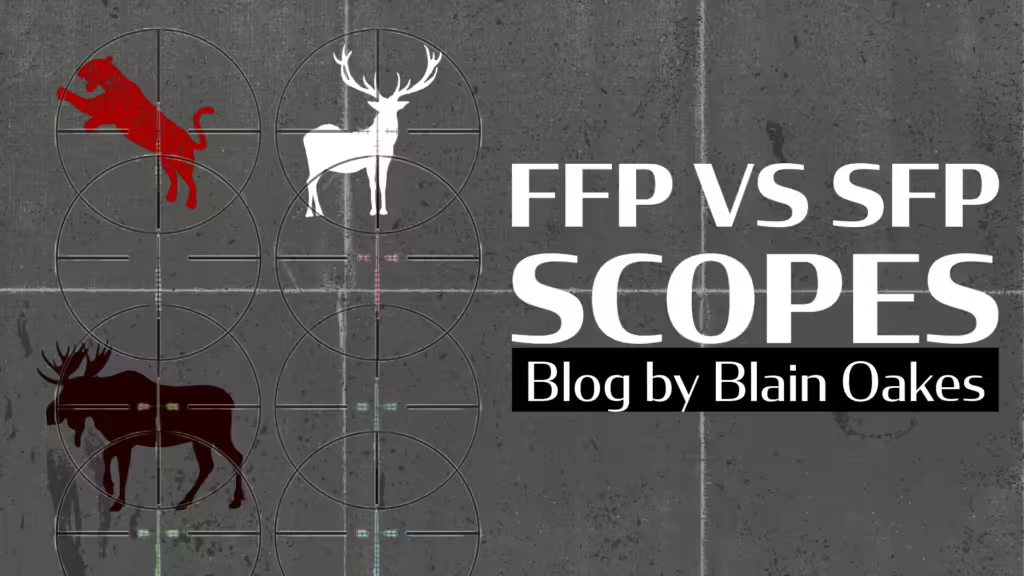
When selecting a new riflescope or low-power variable optic (LPVO), many gun owners, hunters, and shooting enthusiasts tend to focus on the brand, magnification range, or reticle style. Surprisingly, one of the most frequent questions asked isn’t about these features. Instead, it’s the question of whether to go for a First Focal Plane (FFP) or Second Focal Plane (SFP) scope. For someone not deeply embedded in the optics world, this distinction can be confusing. This article will dive deep into FFP vs. SFP scopes, explaining their differences and helping you decide which is better suited for your shooting needs.
FFP vs SFP Scopes: The Basics of Scope Anatomy
To fully understand the difference between FFP and SFP scopes, it’s essential to first grasp some basic scope anatomy. A riflescope consists of several internal glass lenses that work together to provide a clear and magnified image. Starting at the end closest to the shooter’s eye, we have the ocular lens, which is part of the ocular assembly. This assembly also includes the diopter ring, used to adjust the lens to your eye for optimal focus.
Beyond the ocular assembly lies the second focal plane, followed by the magnification assembly. This part is crucial because it determines how the reticle behaves when you zoom in or out. The picture reversal assembly comes next, a series of lenses that correct the image orientation so it appears correctly to your eye. Finally, we have the first focal plane, followed by the objective assembly, which contains the objective lens—the large lens at the opposite end of the scope.
Now that we understand the layout, let’s break down what FFP and SFP scopes mean and how their designs affect your shooting experience.
What Is an FFP Scope?
An FFP scope has the reticle positioned in front of the magnification assembly, specifically on the first focal plane. This means the reticle adjusts in size as you zoom in or out. When you increase magnification, the reticle increases in size; conversely, when you decrease magnification, the reticle shrinks.
This design ensures that the reticle data, such as windage and bullet drop compensation (BDC), remains accurate regardless of your magnification level. Whether you are shooting at low magnification for a wide field of view or zoomed in for precision, your reticle stays proportional to your target.
What Is an SFP Scope?
In contrast, an SFP scope places the reticle behind the magnification assembly, on the second focal plane. As a result, when you zoom in on a target, the picture enlarges, but the reticle remains the same size. The size of the crosshairs or reticle pattern doesn’t change, even at maximum magnification.
While this design has its advantages, it also comes with some limitations, particularly when it comes to reticle data. The displayed information, such as bullet drop compensators or mil-dots, only remains accurate at one magnification setting—usually the maximum. At lower zoom levels, those marks are no longer representative of the actual holdover or windage adjustments you need.
FFP vs SFP: Key Differences
The fundamental difference between FFP and SFP scopes is where the reticle is positioned and how it behaves during magnification. However, this difference leads to various practical implications that shooters should consider based on their intended use. Below are the key differences and the impact on the shooting experience:
Reticle Behavior and Accuracy
- FFP Scopes: The reticle adjusts in size with magnification. This means the holdover points, windage marks, and other reticle features are accurate at any zoom level. For precision shooters who need consistent data, FFP scopes are highly advantageous.
- SFP Scopes: The reticle remains the same size, no matter the zoom. This is beneficial for shooters who prefer a fixed reticle size, especially in low-light or fast-target acquisition situations. However, the accuracy of the reticle’s information is limited to one magnification setting.
Low-Light Performance
In low-light conditions, the ability to quickly and clearly see the reticle can be crucial, especially in hunting scenarios where shooting typically happens at dawn or dusk.
- FFP Scopes: At low magnification, the reticle can become very thin and difficult to see in poor lighting, making quick shots harder to execute.
- SFP Scopes: The constant reticle size makes target acquisition easier, as the crosshairs remain sharp and visible, even in low-light conditions. This can be especially important for hunters or shooters operating in dense environments like forests or underbrush.
Versatility and Application
The decision between FFP and SFP scopes often comes down to how and where you’ll be using your rifle. Each type has strengths in different shooting environments:
- FFP Scopes: These are well-suited for long-range shooting and precision shooting, as the reticle’s accuracy at all magnification levels gives you flexibility. They are also common in military and law enforcement applications, where precision and accurate holdovers are critical.
- SFP Scopes: If you’re involved in hunting or situations where rapid target acquisition is needed, SFP scopes tend to perform better. The fixed reticle size allows for more consistency in low-light environments and can be easier to use when taking quick shots at varying distances.
Advantages of an FFP Scope
- Consistent Reticle Accuracy: No matter your magnification level, the holdover and windage markings remain true, making FFP scopes highly reliable for tactical applications and long-range shooting.
- Multi-Reticle Systems: FFP scopes, especially those found in LPVOs, often feature a multi-reticle system. This allows the scope to display a larger, more intuitive reticle (such as a circle-dot) at low magnification while switching to a detailed reticle (such as a BDC or Christmas tree) at higher zoom levels. This versatility makes FFP scopes a solid choice for shooters needing both close-quarters precision and long-range accuracy in a single optic.
- Ideal for Precision: For anyone involved in target shooting, sniper applications, or any activity that demands accurate data regardless of magnification, the FFP scope is a powerful tool.
Advantages of an SFP Scope
- Fixed Reticle Size: SFP scopes provide a constant, easy-to-see reticle, making it ideal for hunting or quick target acquisition, especially in thick brush or during low-light conditions.
- Ease of Use: Since the reticle remains unchanged, there’s no need to adjust to a new reticle size at different magnifications, making SFP scopes simpler to use for shooters who don’t require constant data adjustments.
- Cost-Effective: On average, SFP scopes tend to be less expensive than FFP scopes, which can make them a more budget-friendly option for hunters and recreational shooters.
Which Scope Is Right for You?
The choice between an FFP and an SFP scope ultimately depends on the type of shooting you plan to do. Let’s break down which one might be best for specific activities:
- For Hunting: If you’re stalking game during dawn or dusk, the SFP scope is likely the better choice. Its fixed reticle is easier to see in low light, and the simplicity of not needing constant holdover adjustments makes it a great fit for fast, reactive shooting situations.
- For Precision Shooting or Long-Range Shooting: If precision is paramount, or if you plan on engaging targets at long distances, an FFP scope will provide the consistency and data accuracy you need. Whether you’re dialing in for wind or elevation or taking shots at multiple distances, FFP will deliver the versatility needed.
- For Tactical or Law Enforcement Applications: Law enforcement and military operators frequently benefit from the flexibility of FFP scopes. The ability to use multi-reticle systems ensures quick transitions between close-quarter engagements and intermediate distances, making it a superior choice in dynamic tactical environments.
Final Thoughts on FFP vs SFP Scopes
Choosing between an FFP or SFP scope is a highly personal decision that depends on your shooting style, needs, and the environments in which you operate. Both scopes offer distinct advantages, and neither is definitively better than the other. For hunters and those needing quick target acquisition in variable light conditions, an SFP scope is often the superior choice. Conversely, for precision shooters, law enforcement officers, and anyone needing reticle accuracy across multiple magnification levels, an FFP scope is likely the best fit. The most important thing to remember is that “the mission dictates the gear.”
Whether you’re hunting, practicing at the range, or preparing for a tactical situation, understanding your scope’s reticle system is key to making the most of your shooting experience.
FAQs FFP vs SFP Scopes
What is the main difference between FFP and SFP scopes?
The primary difference is that in an FFP scope, the reticle changes size with magnification, while in an SFP scope, the reticle remains the same size regardless of zoom level.
Which is better for hunting, FFP or SFP?
SFP scopes are generally better for hunting because the reticle remains constant, making it easier to see in low-light conditions and during fast target acquisition.
Are FFP scopes more expensive than SFP scopes?
Yes, on average, FFP scopes are more expensive due to the complexity of their design and their ability to maintain reticle accuracy at all magnifications.
Can I use an FFP scope for close-range shooting?
Yes, but FFP scopes are more often chosen for long-range or precision shooting. However, some FFP scopes, particularly LPVOs, offer multi-reticle systems that work well for both close and long-range engagements.
Do SFP scopes have any disadvantages?
The main disadvantage of SFP scopes is that the reticle’s holdover and windage data are only accurate at one magnification setting, typically the maximum.
Can you switch between FFP and SFP on the same scope?
No, FFP and SFP scopes are distinct designs, and you cannot switch between the two on a single scope.






